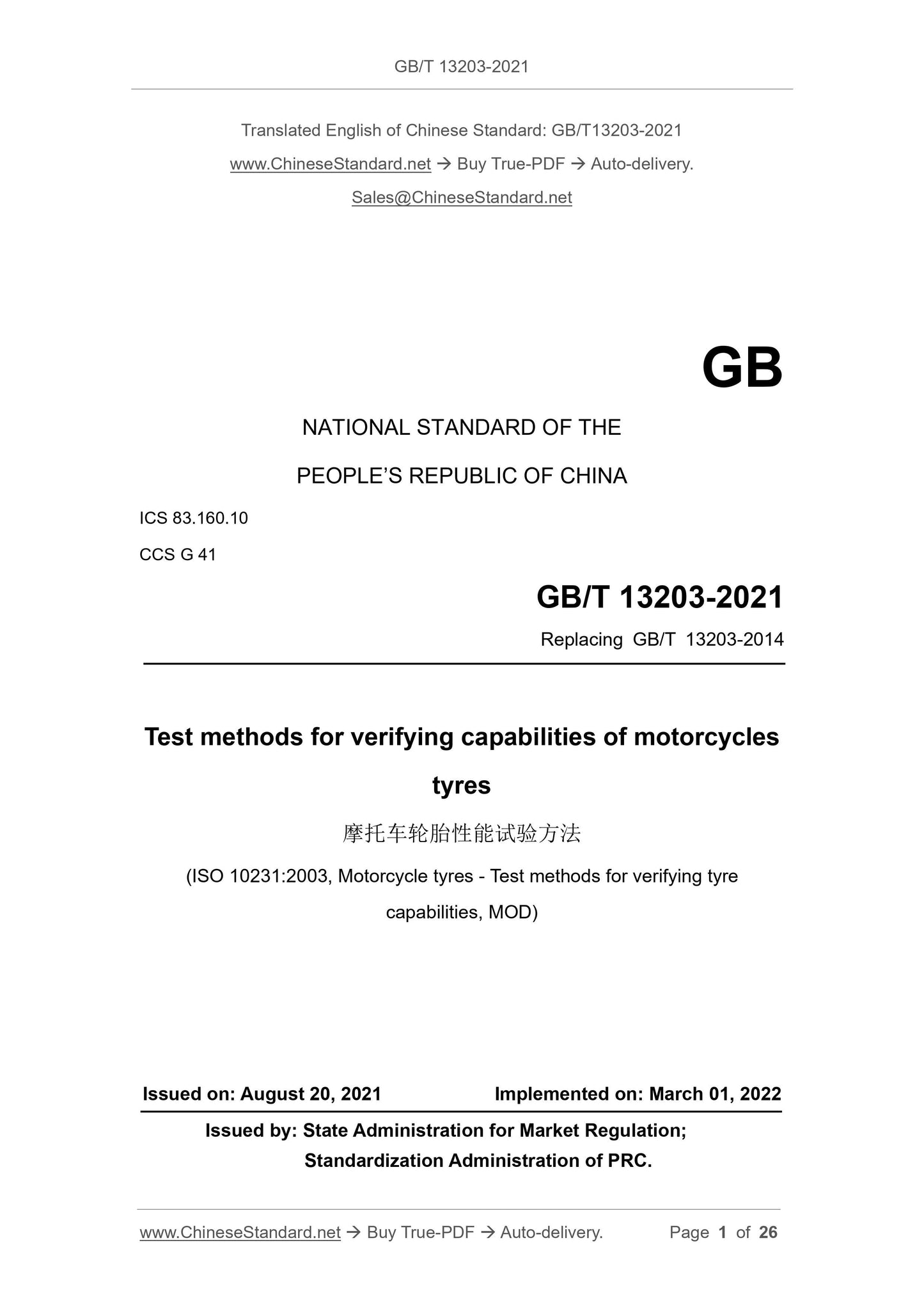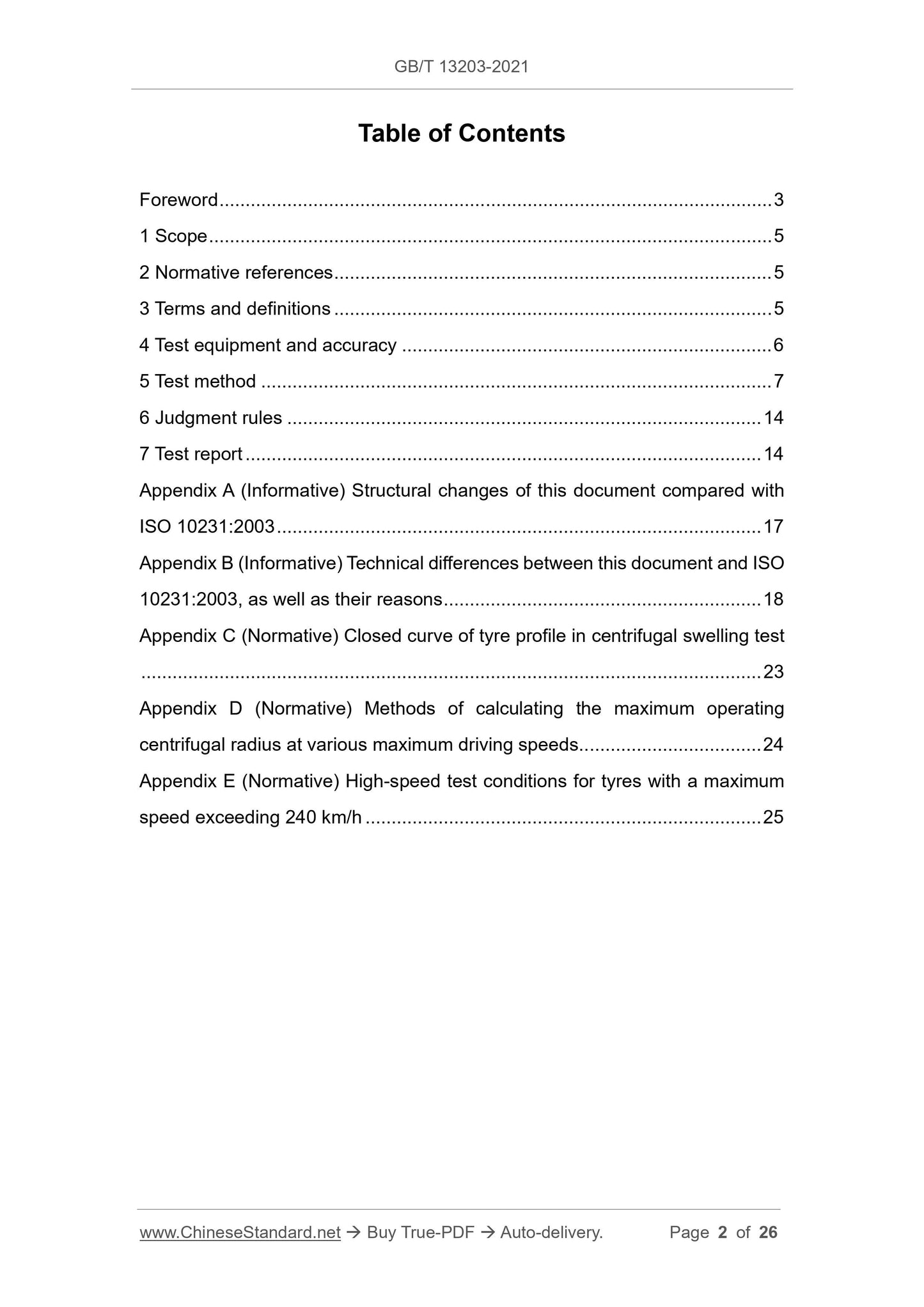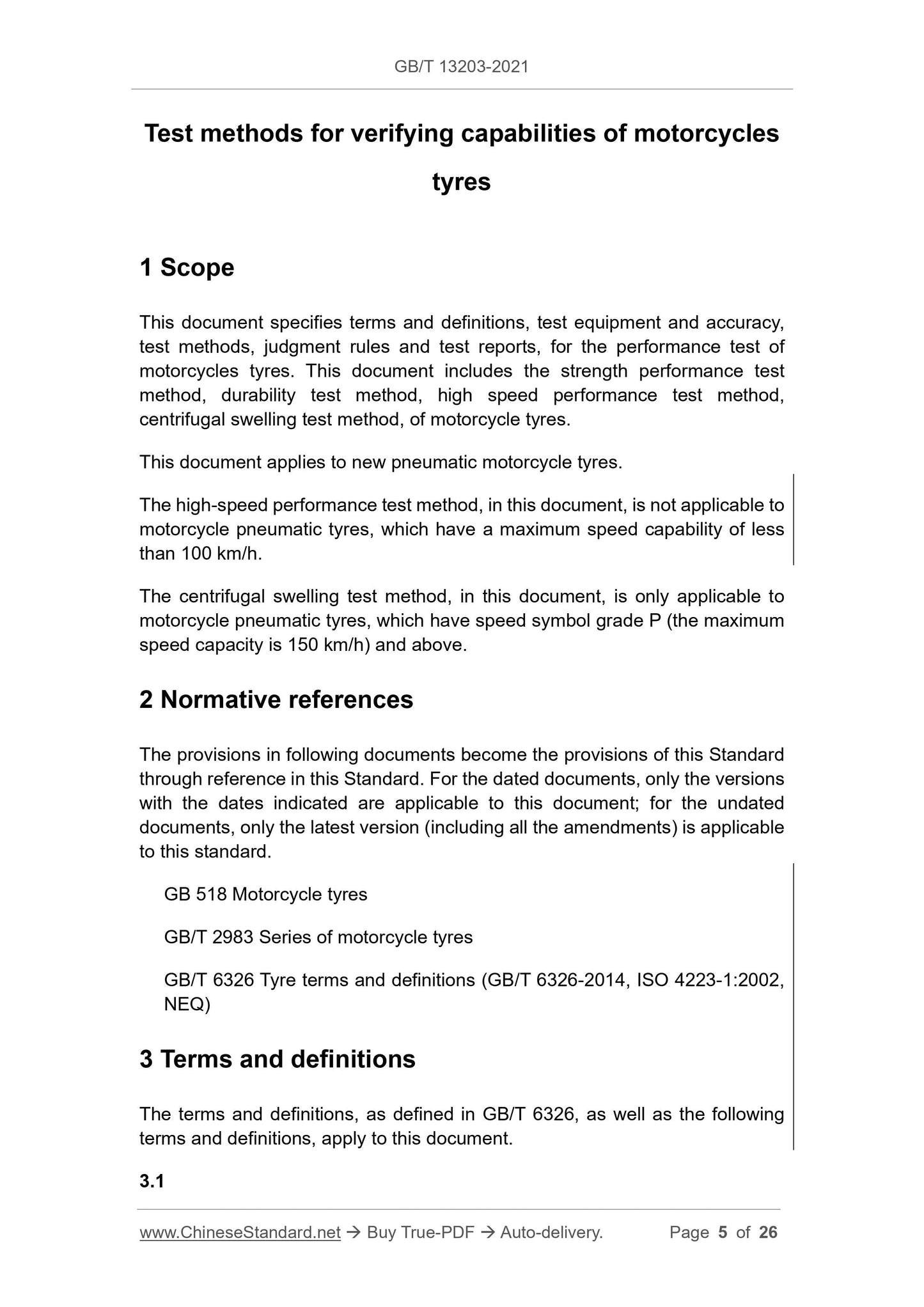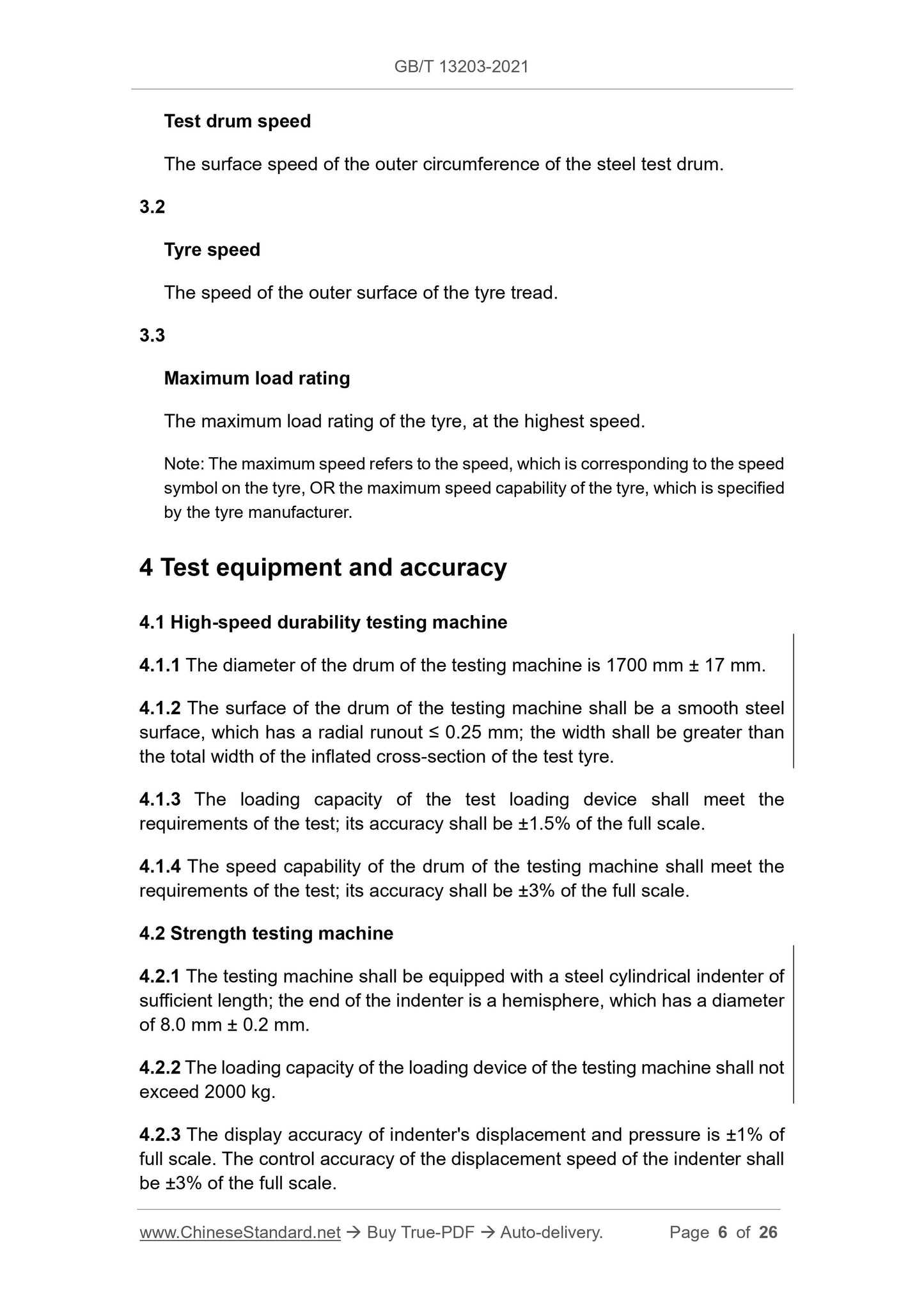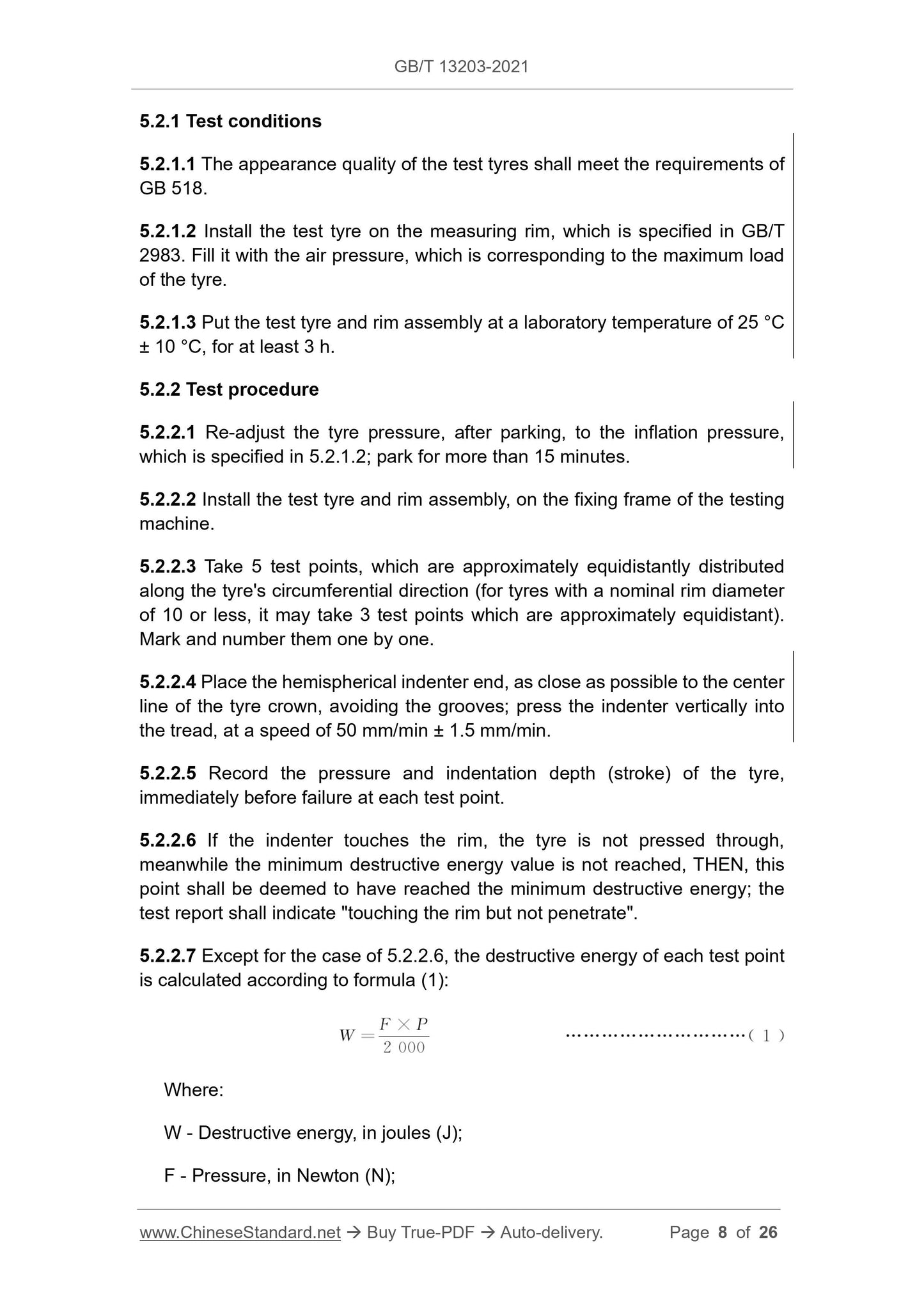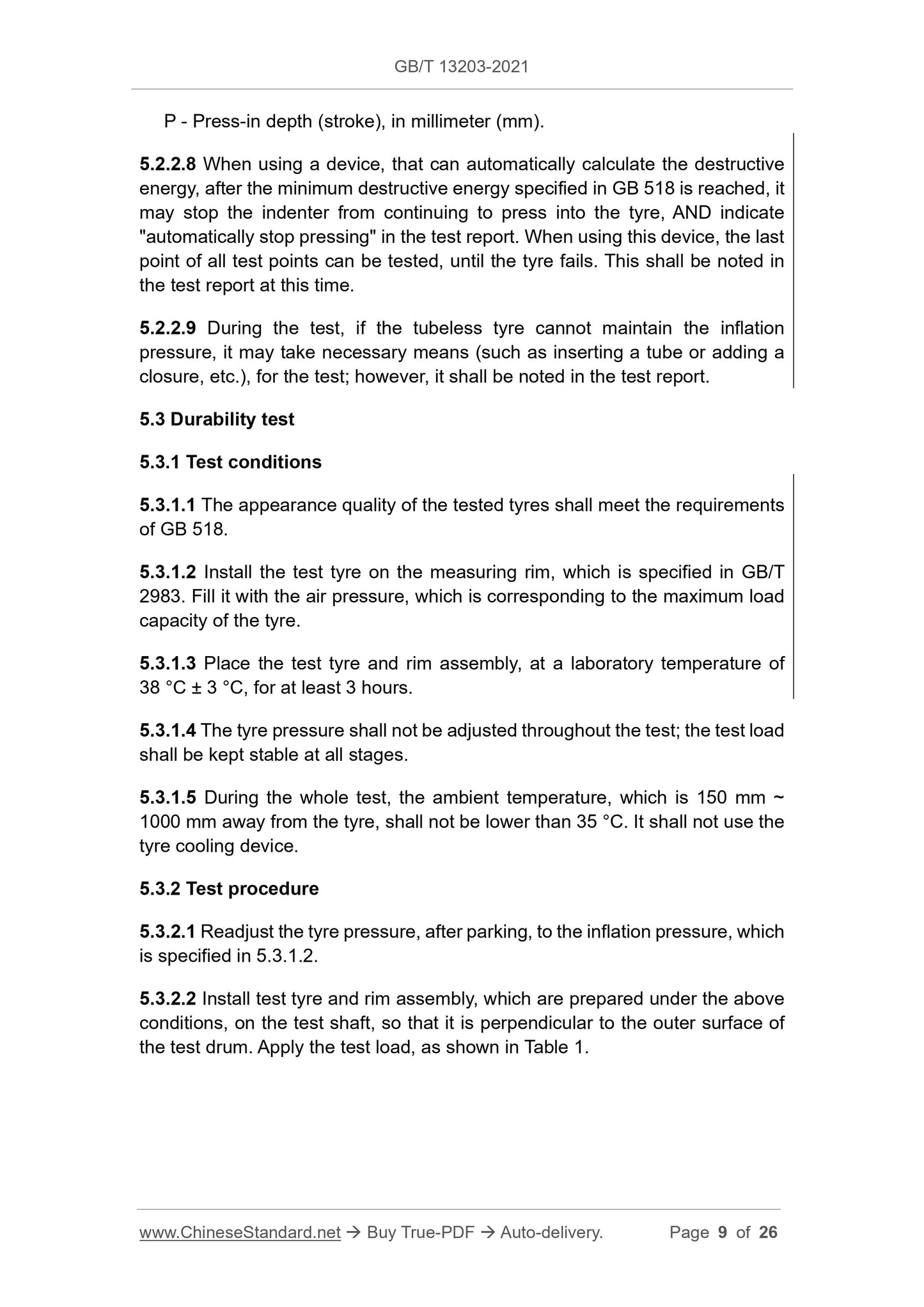1
/
of
7
www.ChineseStandard.us -- Field Test Asia Pte. Ltd.
GB/T 13203-2021 English PDF (GB/T13203-2021)
GB/T 13203-2021 English PDF (GB/T13203-2021)
Regular price
$155.00
Regular price
Sale price
$155.00
Unit price
/
per
Shipping calculated at checkout.
Couldn't load pickup availability
GB/T 13203-2021: Test methods for verifying capabilities of motorcycle tyres
Delivery: 9 seconds. Download (& Email) true-PDF + Invoice.
Get Quotation: Click GB/T 13203-2021 (Self-service in 1-minute)
Historical versions (Master-website): GB/T 13203-2021
Preview True-PDF (Reload/Scroll-down if blank)
GB/T 13203-2021
GB
NATIONAL STANDARD OF THE
PEOPLE’S REPUBLIC OF CHINA
ICS 83.160.10
CCS G 41
Replacing GB/T 13203-2014
Test methods for verifying capabilities of motorcycles
tyres
(ISO 10231:2003, Motorcycle tyres - Test methods for verifying tyre
capabilities, MOD)
ISSUED ON: AUGUST 20, 2021
IMPLEMENTED ON: MARCH 01, 2022
Issued by: State Administration for Market Regulation;
Standardization Administration of PRC.
Table of Contents
Foreword ... 3
1 Scope ... 5
2 Normative references ... 5
3 Terms and definitions ... 5
4 Test equipment and accuracy ... 6
5 Test method ... 7
6 Judgment rules ... 14
7 Test report ... 14
Appendix A (Informative) Structural changes of this document compared with
ISO 10231:2003 ... 17
Appendix B (Informative) Technical differences between this document and ISO
10231:2003, as well as their reasons ... 18
Appendix C (Normative) Closed curve of tyre profile in centrifugal swelling test
... 23
Appendix D (Normative) Methods of calculating the maximum operating
centrifugal radius at various maximum driving speeds ... 24
Appendix E (Normative) High-speed test conditions for tyres with a maximum
speed exceeding 240 km/h ... 25
Test methods for verifying capabilities of motorcycles
tyres
1 Scope
This document specifies terms and definitions, test equipment and accuracy,
test methods, judgment rules and test reports, for the performance test of
motorcycles tyres. This document includes the strength performance test
method, durability test method, high speed performance test method,
centrifugal swelling test method, of motorcycle tyres.
This document applies to new pneumatic motorcycle tyres.
The high-speed performance test method, in this document, is not applicable to
motorcycle pneumatic tyres, which have a maximum speed capability of less
than 100 km/h.
The centrifugal swelling test method, in this document, is only applicable to
motorcycle pneumatic tyres, which have speed symbol grade P (the maximum
speed capacity is 150 km/h) and above.
2 Normative references
The provisions in following documents become the provisions of this Standard
through reference in this Standard. For the dated documents, only the versions
with the dates indicated are applicable to this document; for the undated
documents, only the latest version (including all the amendments) is applicable
to this standard.
GB 518 Motorcycle tyres
GB/T 2983 Series of motorcycle tyres
GB/T 6326 Tyre terms and definitions (GB/T 6326-2014, ISO 4223-1:2002,
NEQ)
3 Terms and definitions
The terms and definitions, as defined in GB/T 6326, as well as the following
terms and definitions, apply to this document.
3.1
Test drum speed
The surface speed of the outer circumference of the steel test drum.
3.2
Tyre speed
The speed of the outer surface of the tyre tread.
3.3
Maximum load rating
The maximum load rating of the tyre, at the highest speed.
Note: The maximum speed refers to the speed, which is corresponding to the speed
symbol on the tyre, OR the maximum speed capability of the tyre, which is specified
by the tyre manufacturer.
4 Test equipment and accuracy
4.1 High-speed durability testing machine
4.1.1 The diameter of the drum of the testing machine is 1700 mm ± 17 mm.
4.1.2 The surface of the drum of the testing machine shall be a smooth steel
surface, which has a radial runout ≤ 0.25 mm; the width shall be greater than
the total width of the inflated cross-section of the test tyre.
4.1.3 The loading capacity of the test loading device shall meet the
requirements of the test; its accuracy shall be ±1.5% of the full scale.
4.1.4 The speed capability of the drum of the testing machine shall meet the
requirements of the test; its accuracy shall be ±3% of the full scale.
4.2 Strength testing machine
4.2.1 The testing machine shall be equipped with a steel cylindrical indenter of
sufficient length; the end of the indenter is a hemisphere, which has a diameter
of 8.0 mm ± 0.2 mm.
4.2.2 The loading capacity of the loading device of the testing machine shall not
exceed 2000 kg.
4.2.3 The display accuracy of indenter's displacement and pressure is ±1% of
full scale. The control accuracy of the displacement speed of the indenter shall
be ±3% of the full scale.
4.3 Inflation pressure gauge
The maximum range of the inflation pressure gauge shall not be less than 400
kPa, which has an accuracy of ±10 kPa.
4.4 Centrifugal swelling test device
4.4.1 Test shaft
For the tyre centrifugal swelling test, when measuring the vertical part of the
inner flange of the rim, directly above the bead seat and the bead seat fillet,
THEN, the test shaft and rim shall be controlled, to ensure that the radial
deviation is less than ±0.5 mm AND the lateral deviation is less than ±0.5 mm.
4.4.2 Contour drawing device
For example, design coordinates, cameras, etc. can be used, to obtain a clear
contour line of the maximum point of deformation of the outer contour, on the
tyre's cross-section. The device shall minimize distortion AND ensure that the
drawn outline has a constant (known) ratio to the actual size.
The device shall use the axis of rotation, as a reference for the tyre profile.
The accuracy of the measurement equipment, for tyre's centrifugal swelling test,
shall be ±1% of the full scale.
Note: For the test, which is only to detect whether the centrifugal swelling size of
motorcycle tyres meets the relevant limit, under dynamic conditions, THEN, it may also
select the limit detection method of the centrifugal swelling test (such as photoelectric
control, contour plate control, etc., as shown in 5.5.3). It may establish an enclosing
curve, OR a centrifugal radius control line - that is, the maximum allowable deformation
point of the tread, on the tyre bisector - as the basis for the limit device of the tyre's
centrifugal swelling size. The relevant contour curve is as shown in Appendix C.
5 Test method
5.1 General
Use 3 or 4 tyres, which have the same characteristics (such as specification
mark, maximum load capacity, speed level), as test samples, respectively for
strength performance test, endurance performance test, high-speed
performance test, as well as additional centrifugal swelling test, as needed.
Each test sample shall meet the requirements of the test method, which are
specified in 5.2 ~ 5.5, respectively.
5.2 Strength performance test
5.2.1 Test conditions
5.2.1.1 The appearance quality of the test tyres shall meet the requirements of
GB 518.
5.2.1.2 Install the test tyre on the measuring rim, which is specified in GB/T
2983. Fill it with the air pressure, which is corresponding to the maximum load
of the tyre.
5.2.1.3 Put the test tyre and rim assembly at a laboratory temperature of 25 °C
± 10 °C, for at least 3 h.
5.2.2 Test procedure
5.2.2.1 Re-adjust the tyre pressure, after parking, to the inflation pressure,
which is specified in 5.2.1.2; park for more than 15 minutes.
5.2.2.2 Install the test tyre and rim assembly, on the fixing frame of the testing
machine.
5.2.2.3 Take 5 test points, which are approximately equidistantly distributed
along the tyre's circumferential direction (for tyres with a nominal rim diameter
of 10 or less, it may take 3 test points which are approximately equidistant).
Mark and number them one by one.
5.2.2.4 Place the hemispherical indenter end, as close as possible to the center
line of the tyre crown, avoiding the grooves; press the indenter vertically into
the tread, at a speed of 50 mm/min ± 1.5 mm/min.
5.2.2.5 Record the pressure and indentation depth (stroke) of the tyre,
immediately before failure at each test point.
5.2.2.6 If the indenter touches the rim, the tyre is not pressed through,
meanwhile the minimum destructive energy value is not reached, THEN, this
point shall be deemed to have reached the minimum destructive energy; the
test report shall indicate "touching the rim but not penetrate".
5.2.2.7 Except for the case of 5.2.2.6, the destructive energy of each test point
is calculated according to formula (1):
Where:
W - Destructive energy, in joules (J);
F - Pressure, in Newton (N);
P - Press-in depth (stroke), in millimeter (mm).
5.2.2.8 When using a device, that can automatically calculate the destructive
energy, after the minimum destructive energy specified in GB 518 is reached, it
may stop the indenter from continuing to press into the tyre, AND indicate
"automatically stop pressing" in the test report. When using this device, the last
point of all test points can be tested, until the tyre fails. This shall be noted in
the test report at this time.
5.2.2.9 During the test, if the tubeless tyre cannot maintain the inflation
pressure, it may take necessary means (such as inserting a tube or adding a
closure, etc.), for the test; however, it shall be noted in the test report.
5.3 Durability test
5.3.1 Test conditions
5.3.1.1 The appearance quality of the tested tyres shall meet the requirements
of GB 518.
5.3.1.2 Install the test tyre on the measuring rim, which is specified in GB/T
2983. Fill it with the air pressure, which is corresponding to the maximum load
capacity of the tyre.
5.3.1.3 Place the test tyre and rim assembly, at a laboratory temperature of
38 °C ± 3 °C, for at least 3 hours.
5.3.1.4 The tyre pressure shall not be adjusted throughout the test; the test load
shall be kept stable at all stages.
5.3.1.5 During the whole test, the ambient temperature, which is 150 mm ~
1000 mm away from the tyre, shall not be lower than 35 °C. It shall not use the
tyre cooling device.
5.3.2 Test procedure
5.3.2.1 Readjust the tyre pressure, after parking, to the inflation pressure, which
is specified in 5.3.1.2.
5.3.2.2 Install test tyre and rim assembly, which are prepared under the above
conditions, on the test shaft, so that it is perpendicular to the outer surface of
the test drum. Apply the test load, as shown in Table 1.
GB/T 13203-2021
GB
NATIONAL STANDARD OF THE
PEOPLE’S REPUBLIC OF CHINA
ICS 83.160.10
CCS G 41
Replacing GB/T 13203-2014
Test methods for verifying capabilities of motorcycles
tyres
(ISO 10231:2003, Motorcycle tyres - Test methods for verifying tyre
capabilities, MOD)
ISSUED ON: AUGUST 20, 2021
IMPLEMENTED ON: MARCH 01, 2022
Issued by: State Administration for Market Regulation;
Standardization Administration of PRC.
Table of Contents
Foreword ... 3
1 Scope ... 5
2 Normative references ... 5
3 Terms and definitions ... 5
4 Test equipment and accuracy ... 6
5 Test method ... 7
6 Judgment rules ... 14
7 Test report ... 14
Appendix A (Informative) Structural changes of this document compared with
ISO 10231:2003 ... 17
Appendix B (Informative) Technical differences between this document and ISO
10231:2003, as well as their reasons ... 18
Appendix C (Normative) Closed curve of tyre profile in centrifugal swelling test
... 23
Appendix D (Normative) Methods of calculating the maximum operating
centrifugal radius at various maximum driving speeds ... 24
Appendix E (Normative) High-speed test conditions for tyres with a maximum
speed exceeding 240 km/h ... 25
Test methods for verifying capabilities of motorcycles
tyres
1 Scope
This document specifies terms and definitions, test equipment and accuracy,
test methods, judgment rules and test reports, for the performance test of
motorcycles tyres. This document includes the strength performance test
method, durability test method, high speed performance test method,
centrifugal swelling test method, of motorcycle tyres.
This document applies to new pneumatic motorcycle tyres.
The high-speed performance test method, in this document, is not applicable to
motorcycle pneumatic tyres, which have a maximum speed capability of less
than 100 km/h.
The centrifugal swelling test method, in this document, is only applicable to
motorcycle pneumatic tyres, which have speed symbol grade P (the maximum
speed capacity is 150 km/h) and above.
2 Normative references
The provisions in following documents become the provisions of this Standard
through reference in this Standard. For the dated documents, only the versions
with the dates indicated are applicable to this document; for the undated
documents, only the latest version (including all the amendments) is applicable
to this standard.
GB 518 Motorcycle tyres
GB/T 2983 Series of motorcycle tyres
GB/T 6326 Tyre terms and definitions (GB/T 6326-2014, ISO 4223-1:2002,
NEQ)
3 Terms and definitions
The terms and definitions, as defined in GB/T 6326, as well as the following
terms and definitions, apply to this document.
3.1
Test drum speed
The surface speed of the outer circumference of the steel test drum.
3.2
Tyre speed
The speed of the outer surface of the tyre tread.
3.3
Maximum load rating
The maximum load rating of the tyre, at the highest speed.
Note: The maximum speed refers to the speed, which is corresponding to the speed
symbol on the tyre, OR the maximum speed capability of the tyre, which is specified
by the tyre manufacturer.
4 Test equipment and accuracy
4.1 High-speed durability testing machine
4.1.1 The diameter of the drum of the testing machine is 1700 mm ± 17 mm.
4.1.2 The surface of the drum of the testing machine shall be a smooth steel
surface, which has a radial runout ≤ 0.25 mm; the width shall be greater than
the total width of the inflated cross-section of the test tyre.
4.1.3 The loading capacity of the test loading device shall meet the
requirements of the test; its accuracy shall be ±1.5% of the full scale.
4.1.4 The speed capability of the drum of the testing machine shall meet the
requirements of the test; its accuracy shall be ±3% of the full scale.
4.2 Strength testing machine
4.2.1 The testing machine shall be equi...
Delivery: 9 seconds. Download (& Email) true-PDF + Invoice.
Get Quotation: Click GB/T 13203-2021 (Self-service in 1-minute)
Historical versions (Master-website): GB/T 13203-2021
Preview True-PDF (Reload/Scroll-down if blank)
GB/T 13203-2021
GB
NATIONAL STANDARD OF THE
PEOPLE’S REPUBLIC OF CHINA
ICS 83.160.10
CCS G 41
Replacing GB/T 13203-2014
Test methods for verifying capabilities of motorcycles
tyres
(ISO 10231:2003, Motorcycle tyres - Test methods for verifying tyre
capabilities, MOD)
ISSUED ON: AUGUST 20, 2021
IMPLEMENTED ON: MARCH 01, 2022
Issued by: State Administration for Market Regulation;
Standardization Administration of PRC.
Table of Contents
Foreword ... 3
1 Scope ... 5
2 Normative references ... 5
3 Terms and definitions ... 5
4 Test equipment and accuracy ... 6
5 Test method ... 7
6 Judgment rules ... 14
7 Test report ... 14
Appendix A (Informative) Structural changes of this document compared with
ISO 10231:2003 ... 17
Appendix B (Informative) Technical differences between this document and ISO
10231:2003, as well as their reasons ... 18
Appendix C (Normative) Closed curve of tyre profile in centrifugal swelling test
... 23
Appendix D (Normative) Methods of calculating the maximum operating
centrifugal radius at various maximum driving speeds ... 24
Appendix E (Normative) High-speed test conditions for tyres with a maximum
speed exceeding 240 km/h ... 25
Test methods for verifying capabilities of motorcycles
tyres
1 Scope
This document specifies terms and definitions, test equipment and accuracy,
test methods, judgment rules and test reports, for the performance test of
motorcycles tyres. This document includes the strength performance test
method, durability test method, high speed performance test method,
centrifugal swelling test method, of motorcycle tyres.
This document applies to new pneumatic motorcycle tyres.
The high-speed performance test method, in this document, is not applicable to
motorcycle pneumatic tyres, which have a maximum speed capability of less
than 100 km/h.
The centrifugal swelling test method, in this document, is only applicable to
motorcycle pneumatic tyres, which have speed symbol grade P (the maximum
speed capacity is 150 km/h) and above.
2 Normative references
The provisions in following documents become the provisions of this Standard
through reference in this Standard. For the dated documents, only the versions
with the dates indicated are applicable to this document; for the undated
documents, only the latest version (including all the amendments) is applicable
to this standard.
GB 518 Motorcycle tyres
GB/T 2983 Series of motorcycle tyres
GB/T 6326 Tyre terms and definitions (GB/T 6326-2014, ISO 4223-1:2002,
NEQ)
3 Terms and definitions
The terms and definitions, as defined in GB/T 6326, as well as the following
terms and definitions, apply to this document.
3.1
Test drum speed
The surface speed of the outer circumference of the steel test drum.
3.2
Tyre speed
The speed of the outer surface of the tyre tread.
3.3
Maximum load rating
The maximum load rating of the tyre, at the highest speed.
Note: The maximum speed refers to the speed, which is corresponding to the speed
symbol on the tyre, OR the maximum speed capability of the tyre, which is specified
by the tyre manufacturer.
4 Test equipment and accuracy
4.1 High-speed durability testing machine
4.1.1 The diameter of the drum of the testing machine is 1700 mm ± 17 mm.
4.1.2 The surface of the drum of the testing machine shall be a smooth steel
surface, which has a radial runout ≤ 0.25 mm; the width shall be greater than
the total width of the inflated cross-section of the test tyre.
4.1.3 The loading capacity of the test loading device shall meet the
requirements of the test; its accuracy shall be ±1.5% of the full scale.
4.1.4 The speed capability of the drum of the testing machine shall meet the
requirements of the test; its accuracy shall be ±3% of the full scale.
4.2 Strength testing machine
4.2.1 The testing machine shall be equipped with a steel cylindrical indenter of
sufficient length; the end of the indenter is a hemisphere, which has a diameter
of 8.0 mm ± 0.2 mm.
4.2.2 The loading capacity of the loading device of the testing machine shall not
exceed 2000 kg.
4.2.3 The display accuracy of indenter's displacement and pressure is ±1% of
full scale. The control accuracy of the displacement speed of the indenter shall
be ±3% of the full scale.
4.3 Inflation pressure gauge
The maximum range of the inflation pressure gauge shall not be less than 400
kPa, which has an accuracy of ±10 kPa.
4.4 Centrifugal swelling test device
4.4.1 Test shaft
For the tyre centrifugal swelling test, when measuring the vertical part of the
inner flange of the rim, directly above the bead seat and the bead seat fillet,
THEN, the test shaft and rim shall be controlled, to ensure that the radial
deviation is less than ±0.5 mm AND the lateral deviation is less than ±0.5 mm.
4.4.2 Contour drawing device
For example, design coordinates, cameras, etc. can be used, to obtain a clear
contour line of the maximum point of deformation of the outer contour, on the
tyre's cross-section. The device shall minimize distortion AND ensure that the
drawn outline has a constant (known) ratio to the actual size.
The device shall use the axis of rotation, as a reference for the tyre profile.
The accuracy of the measurement equipment, for tyre's centrifugal swelling test,
shall be ±1% of the full scale.
Note: For the test, which is only to detect whether the centrifugal swelling size of
motorcycle tyres meets the relevant limit, under dynamic conditions, THEN, it may also
select the limit detection method of the centrifugal swelling test (such as photoelectric
control, contour plate control, etc., as shown in 5.5.3). It may establish an enclosing
curve, OR a centrifugal radius control line - that is, the maximum allowable deformation
point of the tread, on the tyre bisector - as the basis for the limit device of the tyre's
centrifugal swelling size. The relevant contour curve is as shown in Appendix C.
5 Test method
5.1 General
Use 3 or 4 tyres, which have the same characteristics (such as specification
mark, maximum load capacity, speed level), as test samples, respectively for
strength performance test, endurance performance test, high-speed
performance test, as well as additional centrifugal swelling test, as needed.
Each test sample shall meet the requirements of the test method, which are
specified in 5.2 ~ 5.5, respectively.
5.2 Strength performance test
5.2.1 Test conditions
5.2.1.1 The appearance quality of the test tyres shall meet the requirements of
GB 518.
5.2.1.2 Install the test tyre on the measuring rim, which is specified in GB/T
2983. Fill it with the air pressure, which is corresponding to the maximum load
of the tyre.
5.2.1.3 Put the test tyre and rim assembly at a laboratory temperature of 25 °C
± 10 °C, for at least 3 h.
5.2.2 Test procedure
5.2.2.1 Re-adjust the tyre pressure, after parking, to the inflation pressure,
which is specified in 5.2.1.2; park for more than 15 minutes.
5.2.2.2 Install the test tyre and rim assembly, on the fixing frame of the testing
machine.
5.2.2.3 Take 5 test points, which are approximately equidistantly distributed
along the tyre's circumferential direction (for tyres with a nominal rim diameter
of 10 or less, it may take 3 test points which are approximately equidistant).
Mark and number them one by one.
5.2.2.4 Place the hemispherical indenter end, as close as possible to the center
line of the tyre crown, avoiding the grooves; press the indenter vertically into
the tread, at a speed of 50 mm/min ± 1.5 mm/min.
5.2.2.5 Record the pressure and indentation depth (stroke) of the tyre,
immediately before failure at each test point.
5.2.2.6 If the indenter touches the rim, the tyre is not pressed through,
meanwhile the minimum destructive energy value is not reached, THEN, this
point shall be deemed to have reached the minimum destructive energy; the
test report shall indicate "touching the rim but not penetrate".
5.2.2.7 Except for the case of 5.2.2.6, the destructive energy of each test point
is calculated according to formula (1):
Where:
W - Destructive energy, in joules (J);
F - Pressure, in Newton (N);
P - Press-in depth (stroke), in millimeter (mm).
5.2.2.8 When using a device, that can automatically calculate the destructive
energy, after the minimum destructive energy specified in GB 518 is reached, it
may stop the indenter from continuing to press into the tyre, AND indicate
"automatically stop pressing" in the test report. When using this device, the last
point of all test points can be tested, until the tyre fails. This shall be noted in
the test report at this time.
5.2.2.9 During the test, if the tubeless tyre cannot maintain the inflation
pressure, it may take necessary means (such as inserting a tube or adding a
closure, etc.), for the test; however, it shall be noted in the test report.
5.3 Durability test
5.3.1 Test conditions
5.3.1.1 The appearance quality of the tested tyres shall meet the requirements
of GB 518.
5.3.1.2 Install the test tyre on the measuring rim, which is specified in GB/T
2983. Fill it with the air pressure, which is corresponding to the maximum load
capacity of the tyre.
5.3.1.3 Place the test tyre and rim assembly, at a laboratory temperature of
38 °C ± 3 °C, for at least 3 hours.
5.3.1.4 The tyre pressure shall not be adjusted throughout the test; the test load
shall be kept stable at all stages.
5.3.1.5 During the whole test, the ambient temperature, which is 150 mm ~
1000 mm away from the tyre, shall not be lower than 35 °C. It shall not use the
tyre cooling device.
5.3.2 Test procedure
5.3.2.1 Readjust the tyre pressure, after parking, to the inflation pressure, which
is specified in 5.3.1.2.
5.3.2.2 Install test tyre and rim assembly, which are prepared under the above
conditions, on the test shaft, so that it is perpendicular to the outer surface of
the test drum. Apply the test load, as shown in Table 1.
GB/T 13203-2021
GB
NATIONAL STANDARD OF THE
PEOPLE’S REPUBLIC OF CHINA
ICS 83.160.10
CCS G 41
Replacing GB/T 13203-2014
Test methods for verifying capabilities of motorcycles
tyres
(ISO 10231:2003, Motorcycle tyres - Test methods for verifying tyre
capabilities, MOD)
ISSUED ON: AUGUST 20, 2021
IMPLEMENTED ON: MARCH 01, 2022
Issued by: State Administration for Market Regulation;
Standardization Administration of PRC.
Table of Contents
Foreword ... 3
1 Scope ... 5
2 Normative references ... 5
3 Terms and definitions ... 5
4 Test equipment and accuracy ... 6
5 Test method ... 7
6 Judgment rules ... 14
7 Test report ... 14
Appendix A (Informative) Structural changes of this document compared with
ISO 10231:2003 ... 17
Appendix B (Informative) Technical differences between this document and ISO
10231:2003, as well as their reasons ... 18
Appendix C (Normative) Closed curve of tyre profile in centrifugal swelling test
... 23
Appendix D (Normative) Methods of calculating the maximum operating
centrifugal radius at various maximum driving speeds ... 24
Appendix E (Normative) High-speed test conditions for tyres with a maximum
speed exceeding 240 km/h ... 25
Test methods for verifying capabilities of motorcycles
tyres
1 Scope
This document specifies terms and definitions, test equipment and accuracy,
test methods, judgment rules and test reports, for the performance test of
motorcycles tyres. This document includes the strength performance test
method, durability test method, high speed performance test method,
centrifugal swelling test method, of motorcycle tyres.
This document applies to new pneumatic motorcycle tyres.
The high-speed performance test method, in this document, is not applicable to
motorcycle pneumatic tyres, which have a maximum speed capability of less
than 100 km/h.
The centrifugal swelling test method, in this document, is only applicable to
motorcycle pneumatic tyres, which have speed symbol grade P (the maximum
speed capacity is 150 km/h) and above.
2 Normative references
The provisions in following documents become the provisions of this Standard
through reference in this Standard. For the dated documents, only the versions
with the dates indicated are applicable to this document; for the undated
documents, only the latest version (including all the amendments) is applicable
to this standard.
GB 518 Motorcycle tyres
GB/T 2983 Series of motorcycle tyres
GB/T 6326 Tyre terms and definitions (GB/T 6326-2014, ISO 4223-1:2002,
NEQ)
3 Terms and definitions
The terms and definitions, as defined in GB/T 6326, as well as the following
terms and definitions, apply to this document.
3.1
Test drum speed
The surface speed of the outer circumference of the steel test drum.
3.2
Tyre speed
The speed of the outer surface of the tyre tread.
3.3
Maximum load rating
The maximum load rating of the tyre, at the highest speed.
Note: The maximum speed refers to the speed, which is corresponding to the speed
symbol on the tyre, OR the maximum speed capability of the tyre, which is specified
by the tyre manufacturer.
4 Test equipment and accuracy
4.1 High-speed durability testing machine
4.1.1 The diameter of the drum of the testing machine is 1700 mm ± 17 mm.
4.1.2 The surface of the drum of the testing machine shall be a smooth steel
surface, which has a radial runout ≤ 0.25 mm; the width shall be greater than
the total width of the inflated cross-section of the test tyre.
4.1.3 The loading capacity of the test loading device shall meet the
requirements of the test; its accuracy shall be ±1.5% of the full scale.
4.1.4 The speed capability of the drum of the testing machine shall meet the
requirements of the test; its accuracy shall be ±3% of the full scale.
4.2 Strength testing machine
4.2.1 The testing machine shall be equi...
Share
